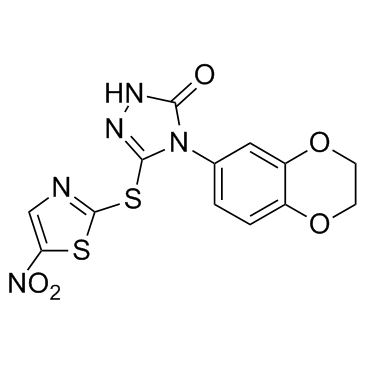| Description |
BI-78D3 functions as a substrate competitive inhibitor of JNK, inhibit the JNK kinase activity (IC50=280 nM).
|
| Related Catalog |
|
| Target |
JNK:280 nM (IC50)
|
| In Vitro |
BI-78D3, dose-dependently inhibits the phosphorylation of JNK substrates both in vitro and in cell. BI-78D3 is able to compete with the D-domain of JIP1 (amino acids 153-163; pepJIP1) for JNK1 binding (IC50=500 nM). Using the same in vitro LanthaScreen kinase assay and the same ATF2 substrate, BI-78D3 is found to be 100-fold less active vs. p38α, a member of the MAPK family with high structural similarity to JNK, and completely inactive against mTOR and PI3-kinase (α-isoform), both unrelated protein kinases. Furthermore, Lineweaver-Burk analysis clearly indicates that BI-78D3 is competitive with ATF2 for binding to JNK1 with an apparent Ki value of 200 nM. In an attempt to profile the properties of BI-78D3 in the context of a complex cellular milieu, the cell-based LanthaScreen kinase assay is used. In this assay BI-78D3 is able to inhibit TNF-α stimulated phosphorylation of c-Jun in cell (EC50=12.4 μM)[1].
|
| In Vivo |
The link between ConA-induced liver failure, TNF receptor signaling, and JNK function has been established by studies employing JNK1-/- and JNK2-/- mice. For this analysis, insulin insensitive mice are injected only once with 25 mg/kg BI-78D3, 30 min before insulin injection. The effect of insulin on blood glucose levels is then measured. BI-78D3 results in a statistically significant reduction in blood glucose levels as compared with the vehicle control. Thus, the ability of BI-78D3 to abrogate ConA-induced liver damage and restore insulin sensitivity is consistent with its proposed function as an effective JNK inhibitor. Liquid chromatography/mass spectrometry bio-availability analysis demonstrates that BI-78D3 has favorable microsome and plasma stability (T1/2=54 min)[1].
|
| Kinase Assay |
The cell based kinase assays for c-Jun and ATF2 phosphorylation carry out by using the LanthaScreen c-Jun (1-79) HeLa and LanthaScreen ATF2 (19-106) A549 cell lines which stably express GFP-c-Jun 1-79 and GFP-ATF2 19-106, respectively. Phosphorylation is determined by measuring the time resolved FRET (TR-FRET) between a terbium labeled phospho-specific antibody and the GFP-fusion protein. The cells are plated in white tissue culture treated 384 well plates at a density of 10,000 cell per well in 32 μl assay medium (supplemented with 1% charcoal/dextran-treated FBS, 100 U/mL Penicillin and 100 μg/mL Streptomycin, 0.1 mM nonessential amino acids, 1 mM sodium pyruvate, 25 mM Hepes, pH 7.3, and lacking phenol red). After overnight incubation, cells are pretreated for 60 min with BI-78D3 (0.001, 0.01, 0.1, 1, 10, and 100 μM) followed by 30 min of stimulation with 2 ng/mL of TNF-α that stimulates both JNK and p38. The medium is then removed by aspiration and the cells are lysed by adding 20 μL of lysis buffer (20 mM Tris•HCl, pH 7.6, 5 mM EDTA, 1% Nonidet P-40 substitute, 5 mM NaF, 150 mM NaCl, and 1:100 protease and phosphatase inhibitor mix, SIGMA P8340 and P2850, respectively). The lysis buffer includs 2 nM of the terbium-labeled anti-pc-Jun (pSer73) or anti-pATF2 (pThr71) detection antibodies. After allowing the assay to equilibrate for 1 h at room temperature, TR-FRET emission ratios are determined on a BMG Pherastar fluorescence plate reader (excitation at 340 nm, emission 520 nm and 490 nm; 100 μs lag time, 200 μs integration time, emission ratio=Em520/Em 490)[1].
|
| Cell Assay |
Mice[1] ConA and BI-78D3 is injected i.v. at 10 mg/kg into 6 to 8 weeks old male BL/6 mice. For partial hepatectomy, mice are anesthetized with isofluorane and subjected to midventral laparotomy followed by removal of the left lateral and median lobes. Animals are killed, blood is collected by cardiac puncture, and livers are surgically removed. Serum is separated and analyzed for alanine-aminotranferase levels[1]. Eleven-week-old male BKS.Cg-+Leprdb/+Leprdb/OlaHsd db/db mice are randomized based on blood glucose levels acclimated three days before drug dosing. Blood glucose is read by using a hand-held glucose meter (Mice are fasted 6 h before i.p. (i.p.) administration of 25 mg/kg BI-78D3. Thirty minutes after test article administration, Bovine Insulin (I-0516 at 0.75 mg/kg) is administered via i.p. injection. Blood samples are taken at designated time points and blood glucose levels are measured as described. Food is returned three hours after test article administration[1].
|
| References |
[1]. Stebbins JL et al. Identification of a new JNK inhibitor targeting the JNK-JIP interaction site. Proc Natl Acad Sci U S A, 2008 Oct 28, 105(43):16809-13.
|
